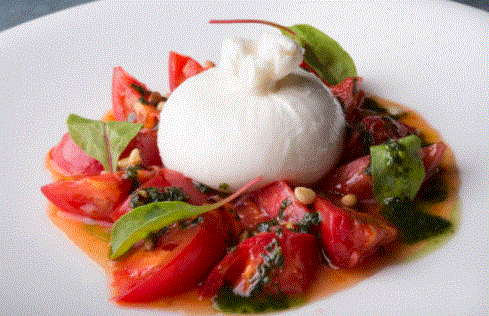Choose the right TOMATOES:
This is the hardest step, but not that hard if it’s the height of tomato season, toward the end of summer.
Look for the juiciest, plumpest tomatoes you can find. A good tomato should feel like a heavy, dense water balloon ready to burst, with no hints of greenness around the stem end (unless, of course, it’s a green variety). If you’ve got one particular breed of heirloom or standard tomato you like, by all means, use just that one.
Really good supermarkets will occasionally have decent tomatoes during the summer, but chances are they won’t. Tomatoes that are shipped long distances on trucks are almost all picked before they’re ripe in order to withstand the bumps and jostles they receive during shipment. This means inferior flavor down the line to you.
If you refrigerate your tomatoes (you definitely should), make sure to take them out of the refrigerator at least long enough to take the chill off before you make your salad. An hour will suffice; four hours is better.
Get Excellent Fresh Mozzarella:
- Fresh from the local dairy. Most people aren’t going to have a local dairy. If you live in a big city with a large Italian and/or hipster population, you might. Quality can vary from producer to producer, but odds are that a local dairy will produce mozzarella that is superior to any of the imports, which lose quality as they sit in their briny packaging. The best mozzarella should be sold while it’s still warm from the dairy.
- Water-packed buffalo mozzarella. The slightly gamey, sour flavor of buffalo mozzarella is often attributed to the milk used, but the reality is that it’s more a function of how long it ages as it travels during shipment.
- Water-packed cow’s-milk mozzarella. There are a few nationally available brands of fresh cow’s-milk mozzarella, packed in water or brine.
- If you have fresh mozzarella from the dairy, do not refrigerate it, as this will cause it to tighten and lose its juicy texture.
Get Excellent Fresh Basil:
This is your easiest task. Look for bright green, non-limp, sweet Italian basil.
Get Excellent Olive Oil:
Crunchy Salt and Coarsely Ground Pepper:
So far our salad is soft on soft on soft, drizzled with liquid. That’s where the salt comes in. The right salt is more than just a seasoning—it provides crunch and little bursts of flavor as you eat. Saltiness has a physiological effect that is quite different from most other flavors, which are defined more by their aroma than by our perception of them on the tongue.
As for pepper, use whole peppercorns and grind them fresh in a good pepper mill, or crush them under a heavy skillet on a hard surface. Good fresh pepper has a sweet flavor, with a quick punch of heat at the end.
Leave it alone:
This is by far the most important rule.
With most recipes, once you’ve gathered the ingredients, you’re ready to begin cooking. With a Caprese salad, you’re done. The less cooking you do, the better. In fact, the less thought you put into it, the better. Cut your tomatoes up into random bite-size pieces, arrange them on a plate, sprinkle them with salt. Tear up your mozzarella (yes, tear, don’t slice; trust me on this) and nestle it into the tomato.
Tear up your basil leaves by hand and scatter them over the top. Season everything with a little more salt and pepper, drizzle with tons of olive oil and put it on the table with some forks.
PERSONAL FEEDBACK:Put away that vinegar. If your tomatoes and mozzarella are good enough, the only thing balsamic vinegar will do is cover up their flavor. If your tomatoes and mozzarella are not great, you shouldn’t be making this salad.
Your balsamic vinegar is most likely just wine vinegar with caramel color added to it.
Enjoy!


